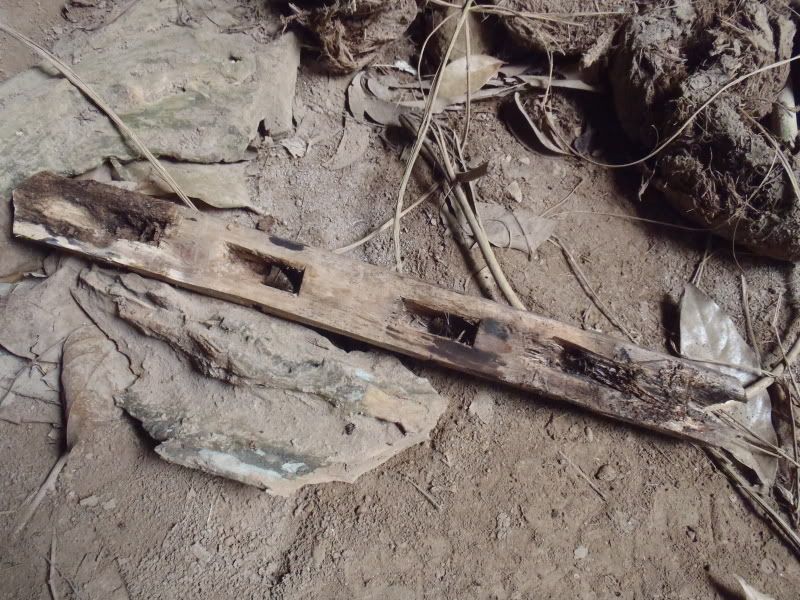A few months ago a kind guide asked me to come along and help him with a group he was bringing into the bush. I had been spending some time in that area on conservation and thought this would be pleasant undemanding work- all I had to do was go in early and make sure everything was sorted out and then accompany the group.
We set off and soon found out that elephants had been using the same route to the river which made things a bit easier as they do a good job of keeping a trail open. No need for machetes! The down side is that you have to stay alert, not just to avoid tail-ending an elephant but to stay on trail since any detour they take will end up looking like the trail.
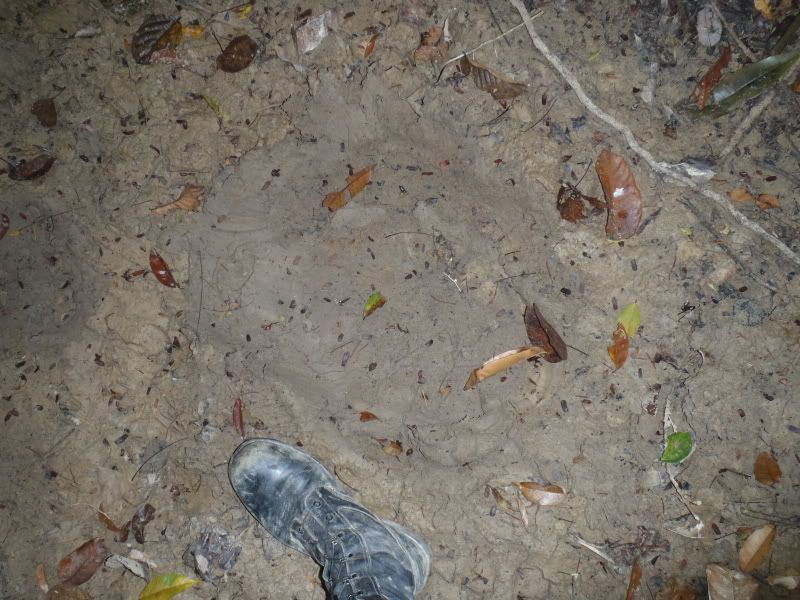
After the first stream crossing things became more interesting when we found the tracks of a tiger. I had been looking for these for weeks; now I had left the measuring rulers in the car since I was mentally in walking not tracking mode. A bit further on we found more tracks and realized that the herd was being followed by not one but two tigers. It was the dry season and streams were drying up; the elephant herd was moving to the river. With the concentration of game down there I doubt if the tigers were thinking of elephant steaks but just using the wide trail for convenience, something tigers often do being fastidious cats.
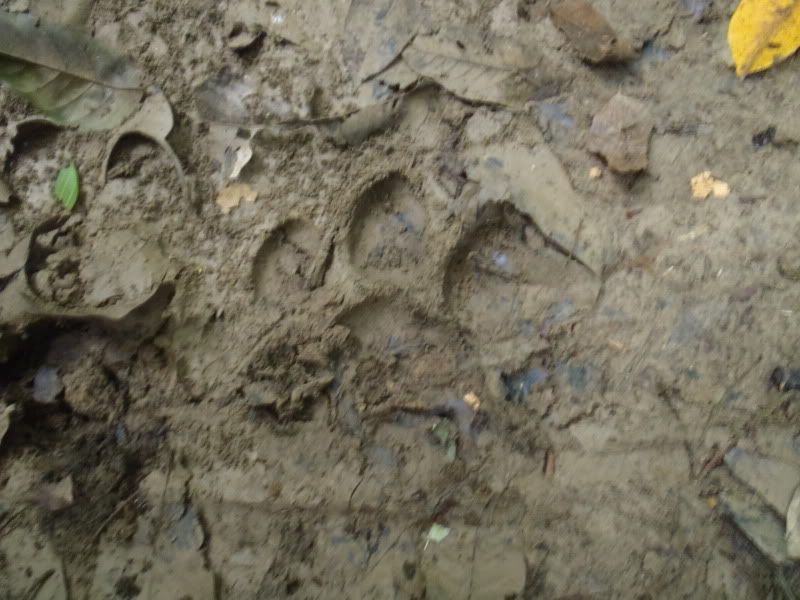
This continued for 5km and I kept falling behind to photograph and record the grid reference for the prints and then trying to catch up hoping to photograph the next set of prints before they became obliterated by the groups boots which left me quite tired. Fortunately they walked carefully.
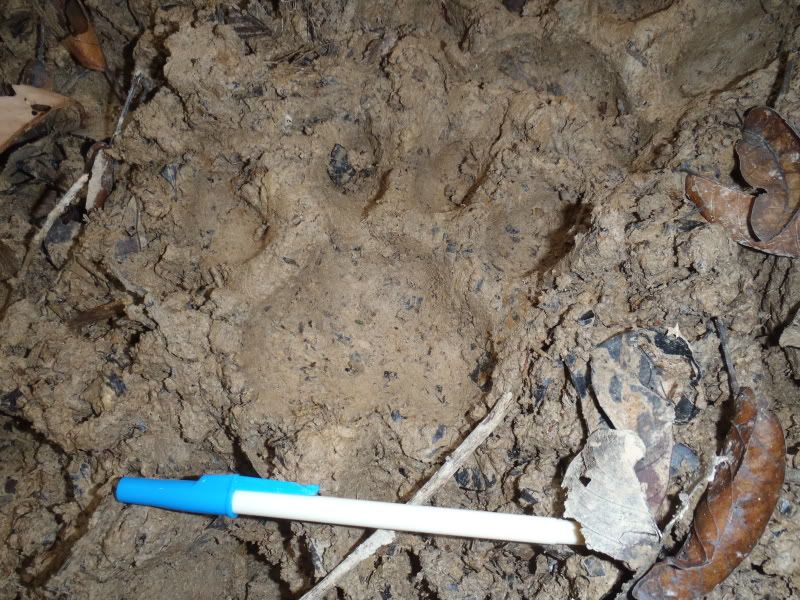
After a few hours we arrived at a limestone outcrop with a cave system and stopped for lunch. It was a hot day. I had already drunk almost 3 litres. I had carried only 4 to save weight. Not wise as dehydration brings about stupidity. I took off my shirt and undershirt which I seldom do out of camp. Some people do but I think its not wise as there are all sorts of things that can make you regret doing so. Looking up, I soon found one of them -Apis dorsata- the largest bee species in the world. A few hives were stuck on the overhanging rock. Not normally aggressive, they do have the numbers and size to ruin your day.

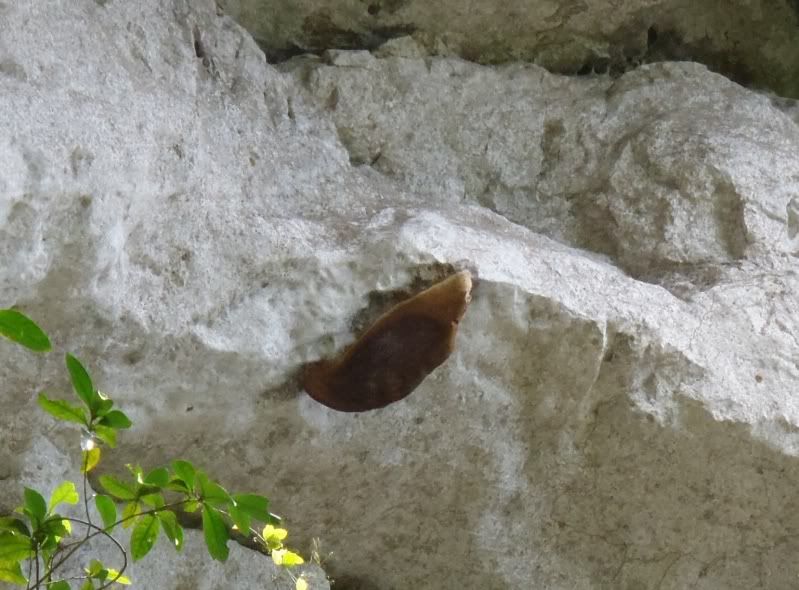
After the break the group went in to look at the caves. I followed to the entrance which had some nondescript charcoal drawings, probably old. The group went in and leaving me alone; I did not have much interest in the cave the whole area is forested karst landscape which I saw quite a bit of in the preceding months. Looking around the entrance, there were several lumps of dried elephant dung. It was a great site for a caveman shelter dry, well ventilated. Packed earth floor.
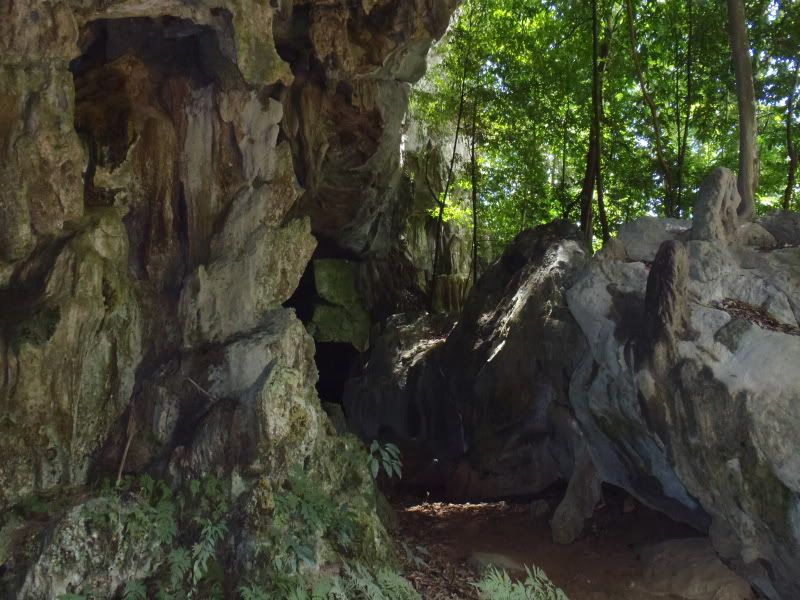

Then my bushcrafters eye saw something at the side of the entrance. I started over, my heart beginning to speed up. I could not believe what I saw.
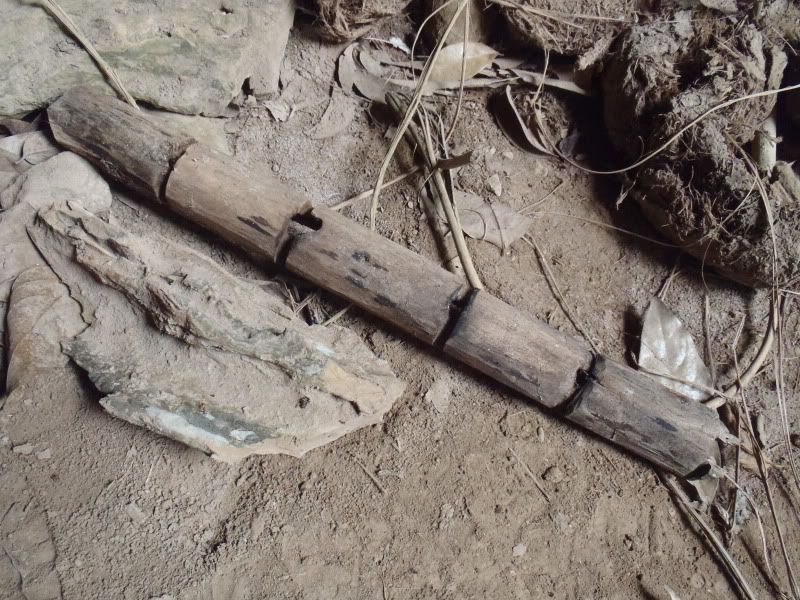
A hearth board for a fire thong! More exciting to a pyro nut than a dinosaur bone or pharaohs tomb.
It was dusty and had been used several times. It looked old. Caveman fantasies swirled around my head caves, cavemen and elephants. The cave was called Elephant cave for good reason. Squatting by the hearth board, I could imagine this cave being used for hundred, if not thousands, of years as a shelter for nomadic hunter-gatherers. In fact a few small relict bands of their descendants still do wander this forest. Looking around, I saw all the preparations for a paleo fire by friction dried dung for superb tinder, small sticks, a few stones and some older broken hearth boards.
I assembled them for this pic.
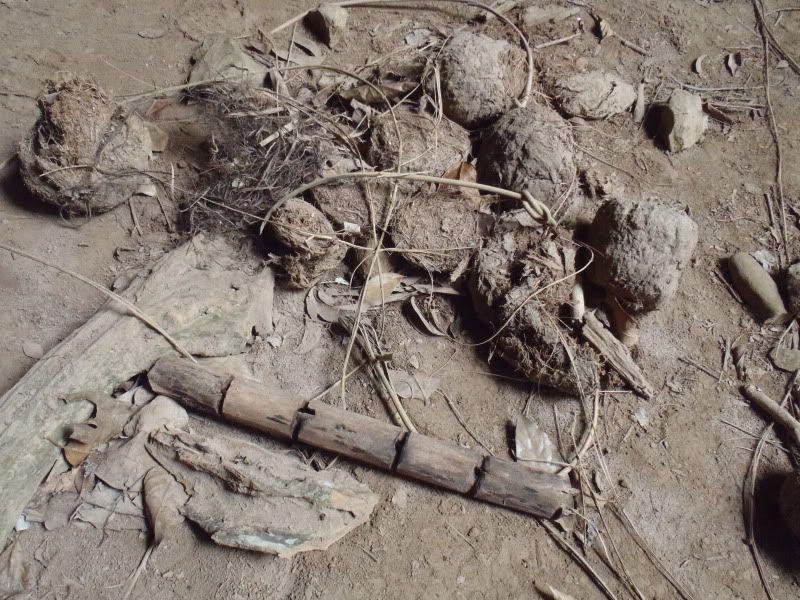

I saw a new board.
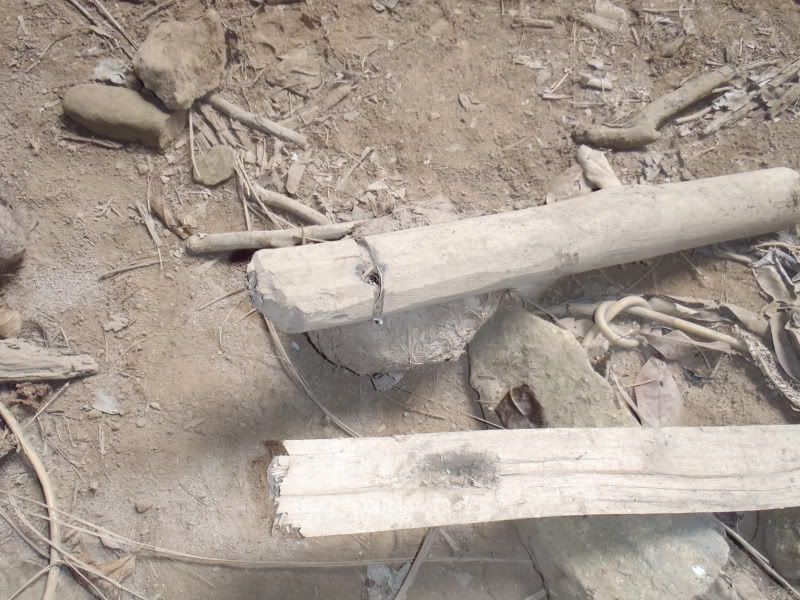
No sign of any implements, bones. Very good house / cave keeping or the work of scavengers. I picked up a dusty length of rattan and flexed it still pliable and not brittle. Not so old after all, maybe a few years no more (I have coils of rattan at home). I must tell Tom, I thought, thinking of Galemys, BCUKs ethnopyrologist.
Then it struck me; why were there no charcoal remnants or any sign of a fire? This place must have been used many times? I scraped away the dust and soil from the likely areas. Nothing. Was the fire buried deeper?
It dawned on me; half completed board - he had never made a fire and had been interrupted. Why leave a perfectly good hearth board?
Elephants coming into the cave while he was getting ready? Maybe. A more worrying thought followed; tigers use caves too. The last print I had recorded was about 70 metres from the cave complex. All the prints were very recent.
Oops. Time to retreat. I felt quite naked in only trousers and boots no parang, no water and only a 2 ½ inch folder. Yeah. Just the blade for an ambush predator!
Picking my way down the slope from the cave entrance I felt stupid - beside the possible tigers and elephants there were the bees I had recent memories of being attacked by a colony of wasps and passing out for an hour.
Back at my kit I felt better with a parang on my belt. While waiting for the others I looked for prints but I could find none leaving the cave area though I did not have time to circumnavigate the entire complex.
When the others returned, we headed back and once they were safe I headed to a creek to cool off and think about the wonderful experience.
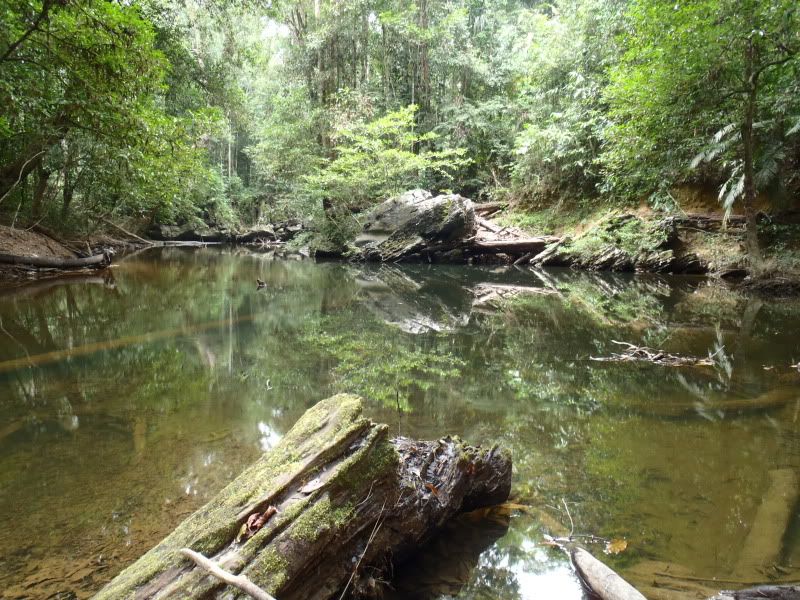
Was there a tiger around? I passed on the co-ordinates and photos, the trail was camera trapped and revealed that Mr. Stripes has moved into the area.
Willam Blake never saw a tiger but his words are apt;
"Tiger Tiger. burning bright,
In the forests of the night;
In what distant deeps or skies.
Burnt the fire of thine eyes?"
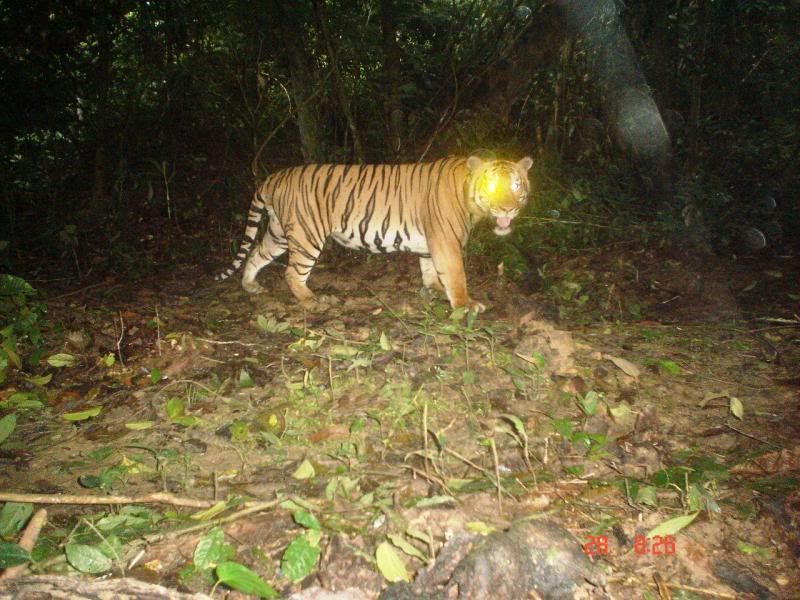
We set off and soon found out that elephants had been using the same route to the river which made things a bit easier as they do a good job of keeping a trail open. No need for machetes! The down side is that you have to stay alert, not just to avoid tail-ending an elephant but to stay on trail since any detour they take will end up looking like the trail.

After the first stream crossing things became more interesting when we found the tracks of a tiger. I had been looking for these for weeks; now I had left the measuring rulers in the car since I was mentally in walking not tracking mode. A bit further on we found more tracks and realized that the herd was being followed by not one but two tigers. It was the dry season and streams were drying up; the elephant herd was moving to the river. With the concentration of game down there I doubt if the tigers were thinking of elephant steaks but just using the wide trail for convenience, something tigers often do being fastidious cats.

This continued for 5km and I kept falling behind to photograph and record the grid reference for the prints and then trying to catch up hoping to photograph the next set of prints before they became obliterated by the groups boots which left me quite tired. Fortunately they walked carefully.

After a few hours we arrived at a limestone outcrop with a cave system and stopped for lunch. It was a hot day. I had already drunk almost 3 litres. I had carried only 4 to save weight. Not wise as dehydration brings about stupidity. I took off my shirt and undershirt which I seldom do out of camp. Some people do but I think its not wise as there are all sorts of things that can make you regret doing so. Looking up, I soon found one of them -Apis dorsata- the largest bee species in the world. A few hives were stuck on the overhanging rock. Not normally aggressive, they do have the numbers and size to ruin your day.


After the break the group went in to look at the caves. I followed to the entrance which had some nondescript charcoal drawings, probably old. The group went in and leaving me alone; I did not have much interest in the cave the whole area is forested karst landscape which I saw quite a bit of in the preceding months. Looking around the entrance, there were several lumps of dried elephant dung. It was a great site for a caveman shelter dry, well ventilated. Packed earth floor.


Then my bushcrafters eye saw something at the side of the entrance. I started over, my heart beginning to speed up. I could not believe what I saw.

A hearth board for a fire thong! More exciting to a pyro nut than a dinosaur bone or pharaohs tomb.
It was dusty and had been used several times. It looked old. Caveman fantasies swirled around my head caves, cavemen and elephants. The cave was called Elephant cave for good reason. Squatting by the hearth board, I could imagine this cave being used for hundred, if not thousands, of years as a shelter for nomadic hunter-gatherers. In fact a few small relict bands of their descendants still do wander this forest. Looking around, I saw all the preparations for a paleo fire by friction dried dung for superb tinder, small sticks, a few stones and some older broken hearth boards.
I assembled them for this pic.


I saw a new board.

No sign of any implements, bones. Very good house / cave keeping or the work of scavengers. I picked up a dusty length of rattan and flexed it still pliable and not brittle. Not so old after all, maybe a few years no more (I have coils of rattan at home). I must tell Tom, I thought, thinking of Galemys, BCUKs ethnopyrologist.
Then it struck me; why were there no charcoal remnants or any sign of a fire? This place must have been used many times? I scraped away the dust and soil from the likely areas. Nothing. Was the fire buried deeper?
It dawned on me; half completed board - he had never made a fire and had been interrupted. Why leave a perfectly good hearth board?
Elephants coming into the cave while he was getting ready? Maybe. A more worrying thought followed; tigers use caves too. The last print I had recorded was about 70 metres from the cave complex. All the prints were very recent.
Oops. Time to retreat. I felt quite naked in only trousers and boots no parang, no water and only a 2 ½ inch folder. Yeah. Just the blade for an ambush predator!
Picking my way down the slope from the cave entrance I felt stupid - beside the possible tigers and elephants there were the bees I had recent memories of being attacked by a colony of wasps and passing out for an hour.
Back at my kit I felt better with a parang on my belt. While waiting for the others I looked for prints but I could find none leaving the cave area though I did not have time to circumnavigate the entire complex.
When the others returned, we headed back and once they were safe I headed to a creek to cool off and think about the wonderful experience.

Was there a tiger around? I passed on the co-ordinates and photos, the trail was camera trapped and revealed that Mr. Stripes has moved into the area.
Willam Blake never saw a tiger but his words are apt;
"Tiger Tiger. burning bright,
In the forests of the night;
In what distant deeps or skies.
Burnt the fire of thine eyes?"


